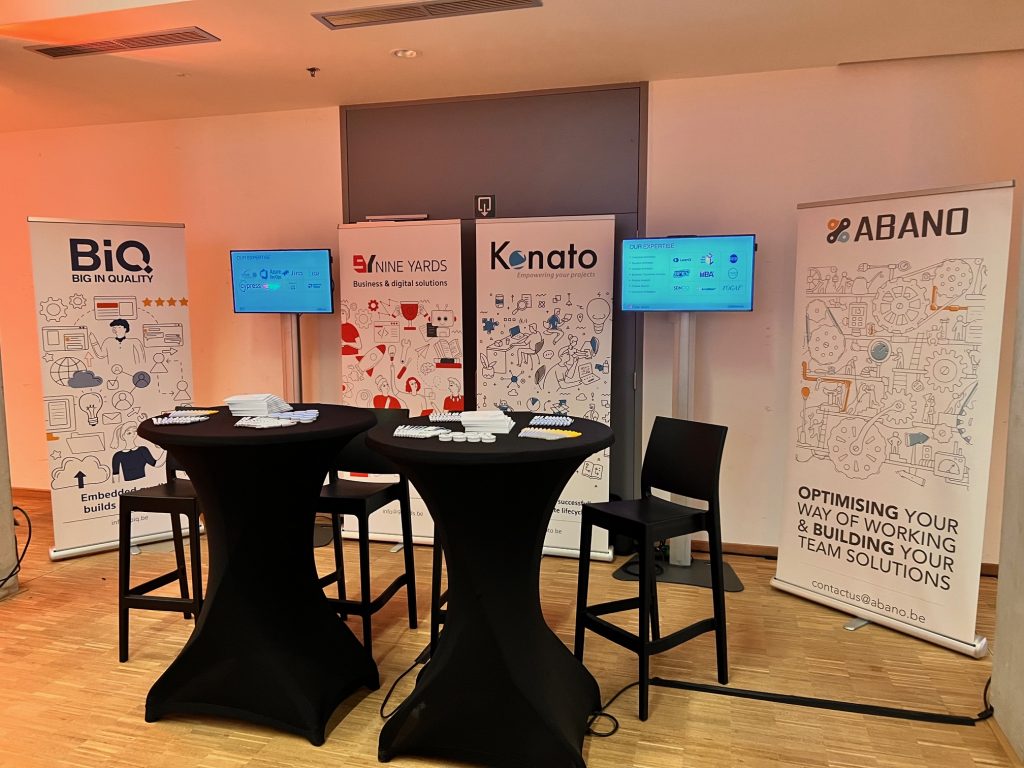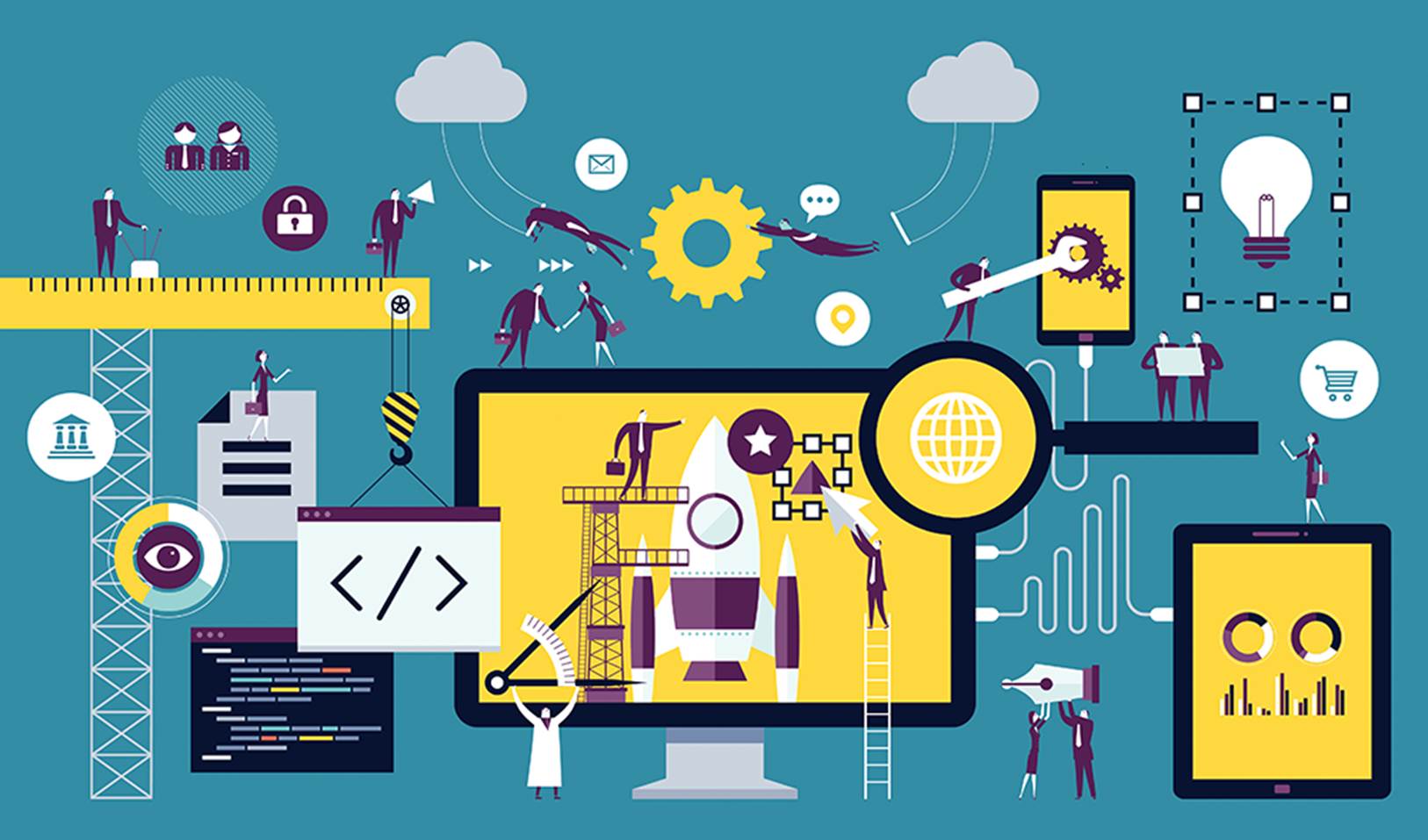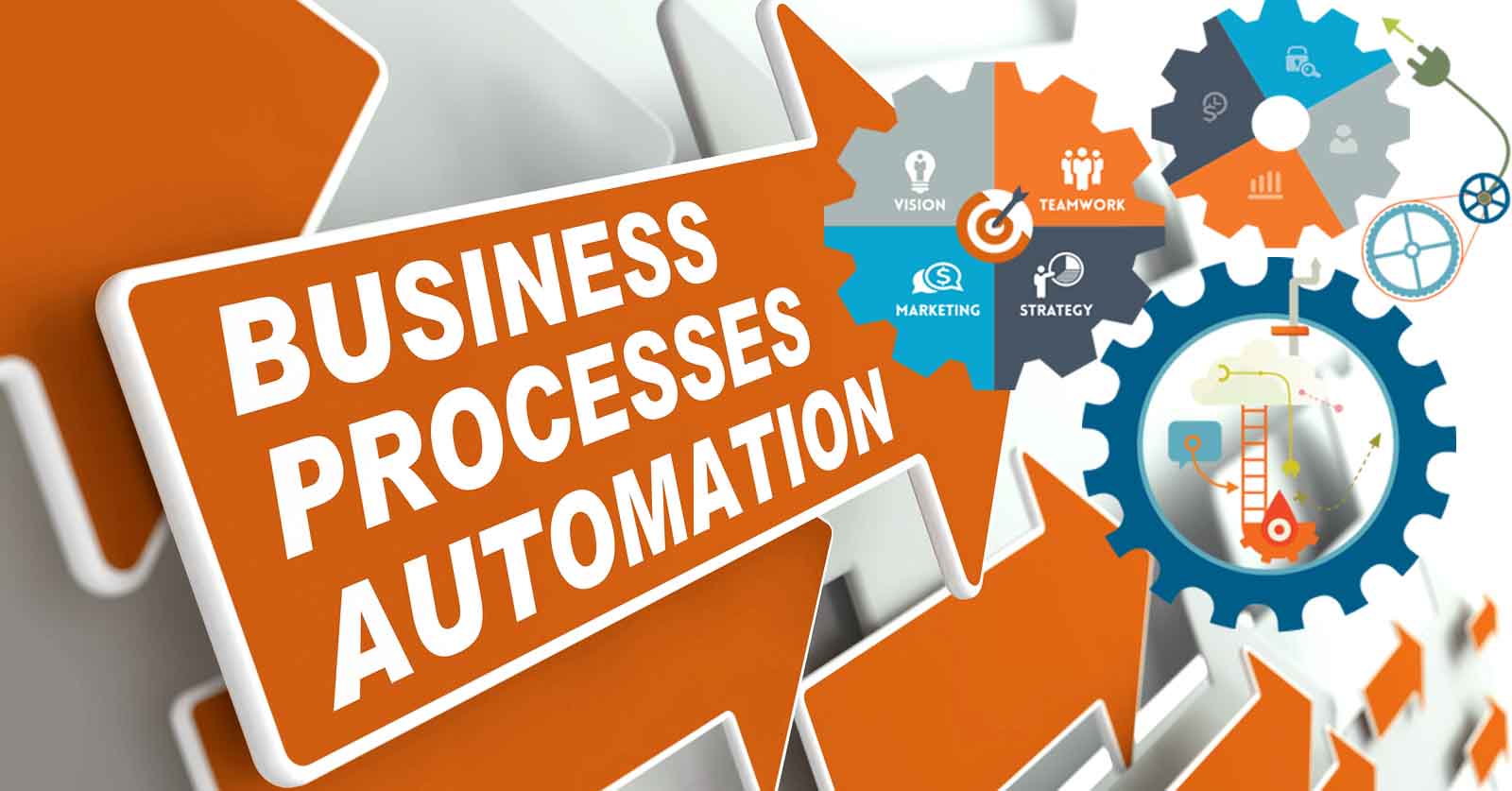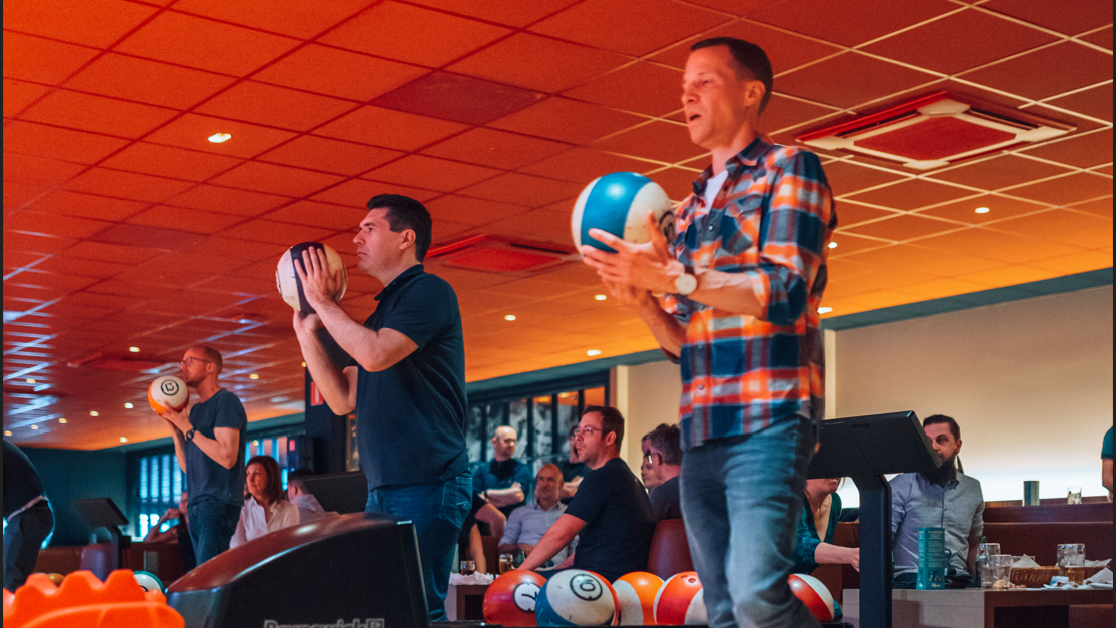francine.callaerts@konato.be Francine Callaerts Talent Acquisition Manager32475939833
 ">
">
Vandaag de dag is flexibiliteit belangrijker dan ooit. Het economische landschap wijzigt constant, de gebruikersmarkt is steeds meer veeleisend, de ene crisis lijkt de andere op te volgen, regels en wetten voor bedrijven worden constant aangepast en dan hebben we het nog niet over de krapte op de arbeidsmarkt.
Het is duidelijk dat flexibel zijn in je onderneming geen optie meer is, het is een voorwaarde geworden om succesvol te blijven.
Nu is dat uiteraard niet zo eenvoudig als zeggen, we moeten flexibel zijn. Er komt veel meer bij kijken. De flexibiliteit moet in de manier van werken en in de opzet van elk project inherent aanwezig zijn.
Als consulting projectleiders komen we in veel bedrijven. Dat wil zeggen dat wij ons regelmatig aanpassen aan een nieuwe omgeving, we komen ook met heel verschillende omgevingen in aanraking.

Flexibiliteit en verandertrajecten vereisen de steun en betrokkenheid van je stakeholders.
Steun: Steun van je stakeholders wil zeggen dat je er niet alleen voor staat. Dat je visie gedragen is. Minder strijd voeren en meer resultaat halen, dat is een win-win.
Betrokkenheid: Je stakeholder kan naast het steunen van je visie deze ook actief mee uitdragen. Je stakeholder heeft immer contacten in het bedrijf, medewerkers die hij mee kan nemen in het steunen van je visie tot verandering.
Elk initiatief heeft een team nodig, een coalitie, die het initiatief omzet tot een project en meewerkt aan de realisatie ervan. Een coalitie onderhouden is veel werk, het vereist regelmatig contact, bevraging van de vorderingen en meningen, communicaties opzetten en de relaties onderhouden om het gedeelde gevoel van samen voor een doel te creëren.

Een duidelijke en overtuigende visie opstellen is om verschillende redenen essentieel voor een bedrijf dat een veranderingsproject doormaakt:
Geeft richting: Een heldere visie dient als baken voor de hele organisatie. Het helpt inspanningen, middelen en initiatieven op één lijn te brengen met het oog op een gemeenschappelijk doel, zodat iedereen zich in dezelfde richting beweegt.
Inspireert en motiveert: Een overtuigende visie inspireert medewerkers en belanghebbenden door een beeld te schetsen van de gewenste toekomstige situatie. Het speelt in op hun ambities en wakkert het enthousiasme en de betrokkenheid bij het veranderingsproces aan.
Bevordert afstemming: In tijden van verandering kunnen werknemers onzekerheid of weerstand ervaren. Een duidelijke visie verduidelijkt het doel en de grondgedachte achter de verandering, waardoor werknemers begrijpen hoe hun rol bijdraagt aan het grotere geheel. Deze afstemming minimaliseert verwarring en vergroot de betrokkenheid.
Creëert focus: Veranderingsprojecten omvatten vaak meerdere bewegende delen en concurrerende prioriteiten. Een goed gedefinieerde visie zorgt voor focus door de meest kritische doelstellingen en prioriteiten te identificeren. Het helpt afleiding weg te filteren en zorgt ervoor dat de organisatie zich kan concentreren op wat er echt toe doet.
Vergemakkelijkt de besluitvorming: Wanneer u tijdens het veranderingsproces met keuzes of uitdagingen wordt geconfronteerd, dient een duidelijke visie als besluitvormingskader. Het biedt criteria voor het evalueren van opties en het bepalen van de beste handelwijze die aansluit bij de gewenste toekomstige situatie.
Verbetert de communicatie: Effectieve communicatie is de sleutel tot succesvol verandermanagement. Een overtuigende visie biedt een krachtig verhaal dat leiders kunnen gebruiken om het doel, de voordelen en de voortgang van het veranderingsinitiatief te communiceren. Het creëert een gedeelde taal en begrip die weerklank vindt in de hele organisatie.
Creëert vertrouwen: Verandering kan verontrustend zijn voor werknemers, belanghebbenden en zelfs klanten. Een duidelijke en overtuigende visie wekt vertrouwen door de toewijding van het leiderschap aan een positief toekomstig resultaat te demonstreren. Het schept vertrouwen door authenticiteit, transparantie en oprechte zorg voor het welzijn van de organisatie en haar mensen over te brengen.

Een transitie succesvol doorvoeren vereist een strategische routekaart die zowel omvattend als aanpasbaar is. Een goede partner om dit proces op te zetten en te onderhouden zorgt ervoor dat je andere taken ook nog een plaats krijgen voor ze een crisis worden. Samen met die partner kan je de route opsplitsen in beheersbare segmenten, specifieke stappen uitwerken en een rijdlijn uitzetten.
De routekaart is een hulp bij het nemen van beslissingen, zetten van prioriteiten en om je veranderproject te communiceren naar stakeholders en naar je teams.
Ondanks de verandering waar ze zelf deel van uitmaken geeft een goede routekaart je teams en stakeholders een houvast, zekerheid en veiligheid waar ze naar op zoek zijn.
Daarom zijn wij als consulting projectmanagers graag die partner die je niet alleen helpt om de transformatie uit te werken, maar ook dat jij je dagelijkse taken kan blijven doen.

Uiteraard gaat een veranderproject niet over één nacht ijs. Door de doorlooptijd is het niet ondenkbaar dat er tijdens de uitvoering parameters wijzigen, omstandigheden aangepast worden of het team de verkeerde richting uit gaat. Daarom is het belangrijk de juiste Key Performance Indicators (KPI’s) op te zetten. Deze zijn ideaal om een verandertraject op te volgen. Samen met je vertrouwde partner stel je de relevante KPI’s op. Deze worden dan regelmatig beoordeeld en zijn zo een aanbeveling voor aanpassingen. Door data als basis te nemen zorgen we ervoor dat je project op koers blijft, zich aanpast aan uitdagingen en opportuniteiten grijpt waar mogelijk.
Je teams werken hard om je projecten op koers te houden en mijlpalen te bereiken. Erkenning van deze prestaties is essentieel om het momentum in je traject vast te houden.
Erkenning geven aan de teams is belangrijk om:
Positieve houding te bewaren: Een positieve houding van je teams zorgt voor een veel beter resultaat. Een negatieve houding is besmettelijk, de prestatie van het hele team gaat hieronder lijden.
Meer energie: Kijk maar eens wat een erkenning met je energie doet. Die gaat omhoog. Hoge energie zorgt voor meer werkplezier en betere productiviteit.
Vertrouwen: Door teams erkenning te geven voor hun prestaties toon je vertrouwen en kweek je loyaliteit. Dit draagt dat weer bij aan motivatie en hoge energie.

Let op, resultaten vieren moet niet altijd iets uitgebreid zijn. Zelfs zonder effectieve beloning zie je dat erkenning vaak bijdraagt aan de motivatie van een team.
Erkenningen mogen in een bedrijf geen wedstrijd worden, dat is in het nadeel van het bedrijf. Belangrijk is dat de erkenning in verhouding staat tot de prestatie.
Een verandertraject in je bedrijf heeft heel veel impact. Op de bezetting van je teams, op het beheersen van communicaties, het uitdragen van een visie en nog veel meer.
Bij Konato nemen wij je het zware werk uit handen, wij nemen je projecten voor onze rekening zodat jij je kan blijven focussen op je belangrijkste taken. Elk van onze consultants brengt een schat aan ervaringen en expertise mee. Deze helpen je om je projecten efficiënt en kwalitatief op te leveren.
Mogen wij je partner zijn om je projecten succesvol op te leveren, je flexibiliteit te verhogen en je competitieve kracht te steunen? Laten we daar samen aan werken.
 ">
">
Last tuesday we gathered at the Meadow Club in Antwerp, Belgium, for an exciting afterwork event. This well-deserved break was again a perfect blend of sports, relaxation, and camaraderie 😊 We kicked off with an hour of padel. Our colleagues took to the courts with enthusiasm, showing off their skills and competitive spirit. After all the intense rallies and thrilling points, it was time to unwind. The refreshing drinks served were just what we needed to cool down.
Time for some barbecue! Typically, this is where we’d mention how lovely the weather was, but given that we live in Belgium, you can imagine how that turned out. 😉 But what the event lacked in sun, was made up by the accommodation, the food and the good company! #mycolleguesarebetterthenyours
Here’s to many more such memorable events in the future, where we can come together, celebrate our achievements, and create awesome memories. Cheers to the Konato family and a big thank you to the team that organized the event!
 ">
">
Technovate 2024, een platform voor innovatie en technologie, bracht dit jaar enkele van de meest vooraanstaande denkers, opinieleiders uit de IT-wereld en visionairs samen om de toekomst van kunstmatige intelligentie (AI) te verkennen. Een van de meest opvallende sprekers op het evenement waren Fiore Fraguelli en zijn collega Simon Uytterhoeven. Ze zijn toonaangevende autoriteiten op het gebied van AI en innovatie. In hun inspirerende keynote, “AI Beyond the Buzz“, deelden ze hun diepgaande inzichten over de rol van AI in de moderne samenleving en benadrukten ze de cruciale rol van menselijkheid in het tijdperk van technologische vooruitgang.

De presentatie opende met de uitspraak: “AI is innovatie op steroïden!“. Ze legden de nadruk op hoe snel de technologie zich ontwikkelt en illustreerde dit met een treffend voorbeeld. Slechts twee jaar geleden was het hoogtepunt van AI een video van Will Smith die spaghetti at. Of was het andersom? Vandaag de dag hebben we Sora, een AI-gestuurde entiteit die niet alleen hetzelfde kan doen, maar met een aanzienlijk betere kwaliteit. Het duo wees erop dat hoewel de basis van tekst-naar-video al in 1956 werd gelegd bij Bell Labs, onder leiding van wetenschappers John Pierce en John R. Pierce, dat de vooruitgang in AI-technologieën vooral de afgelopen jaren exponentieel is toegenomen.
Een van de meest indrukwekkende aspecten van het betoog was de nadruk op het behoud van menselijkheid in een wereld die steeds meer wordt beïnvloed door AI. “Mensen altijd eerst!” is het pleidooi. We moeten terug naar authenticiteit, AI moeten we daarbij zien als een middel om menselijke capaciteiten te verbeteren, niet om ze te vervangen. Ze deelden een citaat van NASA: Mensen zijn de meest kosteneffectieve, niet-lineaire, veelzijdige computers die in massa kunnen worden geproduceerd. Het draait niet om het vinden van AI, maar om het vinden van oplossingen die de menselijke ervaring verrijken.

We kregen een mooi overzicht van implementaties die Cronos AI heeft verwezenlijkt in verschillende sectoren. Dit zijn niet de minsten, het gaat over bedrijven als Puratos, International Logistics Group en de Vlaamse Overheid. Bij elk van deze klanten heeft Cronos AI met succes AI geïntegreerd in de bedrijfsprocessen. Deze implementaties variëren van zoeken naar ingrediënten en het interpreteren van veiligheidsinformatiebladen tot het verbeteren van de toegankelijkheid van informatie binnen complexe organisatiestructuren.
Maar wat brengt de toekomst voor AI? Het duo suggereerde dat AI kan dienen als:
Ze benadrukten het belang van het gebruik van data vanuit de organisatie zelf, in plaats van alleen te vertrouwen op de kennis van AI.
In een wereld die snel evolueert naar een diepere integratie van AI, ligt de sleutel tot succes in het behouden van menselijke waarden en het benutten van de kracht van AI om innovatie te stimuleren en problemen op te lossen. Het is niet genoeg om simpelweg de nieuwste AI-technologieën te omarmen. We moeten een evenwicht vinden tussen technologische vooruitgang en menselijke waarden. “Technovate 2024” kan wel eens het begin zijn van een diepgaande discussie over de toekomst van kunstmatige intelligentie en de rol ervan in onze samenleving. Het is duidelijk dat AI een krachtige tool is die ons kan helpen onze grenzen te verleggen en nieuwe horizonten te verkennen. Maar laten we niet vergeten dat, te midden van alle technologische vooruitgang, onze menselijkheid altijd op de eerste plaats moet staan.
Interesse hoe Konato uw bedrijf kan helpen bij het implementeren van je projecten, al dan niet met AI?
Neem dan zeker contact, we horen graag van je!
 ">
">
Vorige week was er bij ons dochterbedrijf Nine Yards een boeiende workshop over Domain-Driven Design en Event Storming ! 💡 Samen hebben ze de wereld van events en commands verkend en gebruik gemaakt van OpenAI-ondersteuning om de inzichten te verdiepen. Een inspirerende sessie die de creativiteit en samenwerking stimuleerde! Blijf geïnspireerd en blijf leren! 🌈🚀

 ">
">
Bimodel IT is a two-tiered IT operations model which was introduced by Gartner around 2014. It defines the two tiers as “Mode 1, traditional and sequential, emphasizing safety and accuracy, also referred to as exploitation. Mode 2 is exploratory, nonlinear, emphasizing agility and speed.
Each mode will require a different management approach. Processes, organizational structures and people will be different. The pitfall of this model is to just start splitting the IT-systems into these different modes. Splitting the IT-landscape in legacy systems, CRM, ERP, mobile apps,… . Two separate IT groups working at different speeds will not lead to organizational performance. This problem is already raised in many academic reviews on ambidexterity in organizations. It is the balance between exploration and exploitation which will lead to organizational performance.
This shows the need for a proper IT governance, organization structures, hybrid models combining best of both worlds. Forcing an organization into a ‘exploratory’ mode will result in organizational issues, impacting the performance of the organization. Don’t forget that ‘innovative’ companies like Apple have supporting processes which focus on efficiency otherwise they don’t manage the selling and delivery of million products each year. They succeed in combining the two modes and are not only ‘innovative’ as they bring their products into the world.
Digital transformations will handle the questions how to reach this equilibrium, where to start? Focus first on the transformation of the legacy systems? Shift to SAAS-models? Which IT project governance to use? One size doesn’t fit all, therefore the management of an organization needs to be aware of these choices, a proper enterprise architecture will guide in this process. Key is the alignment of the business strategy with the IT-strategy. Digital transformation is not only introducing a mobile app into the organizations or start working in Scrum teams. It is about focusing on the right organizational change within the company.
– Nico Schaetsaert
 ">
">
Intelligent automation (IA) is seen as the next phase of process automation. A few years ago, robotic process automation (RPA) was introduced in many industries across Banking, Insurance, Retail, Logistics and Telecom. Although we see that many traditional RPA deployments are still failing. Reasons are complex business processes, including many rules, exceptions or even processes which are not known end-to-end. Introducing only an RPA solution will not solve this issue of dynamic processes. A proper process management is still needed in the organizations to make the process automation successful. A process centric view is still needed from the beginning, process analysis and optimizations are still part of the solution.
Besides this, the operational costs of a process automation are still increasing in organizations. Changing UI’s, processes, forms and documents will impact the automated tasks. The introduction of intelligent automation can solve these issues. These tools can recognize changes in forms, UI and processes by using AI and can correct the automated processes by using machine learning.
Intelligent process automation, supported by process management will become rapidly the next-generation operating model. We see that vendors like UIPath, Blueprism,… are adapting their tools, so the next phase of digital transformation can be started.
– Nico Schaetsaert
 ">
">
Sinds het begin van dit decennium is DevOps voor velen geëvolueerd van een hol buzzword naar een effectieve implementatie van een betere samenwerking tussen development en operations. Aangezien meerdere organisaties dit principe beginnen op te pikken, geven we enkel belangerijke ‘key takeaways’ mee:
DevOps draait om meer dan louter een snelle pijplijn om code in productie te krijgen.
Alhoewel een snelle time to market van nieuwe functionaliteit zeker een kernonderdeel van DevOps kan genoemd worden, speelt de menselijke aanpak een nog belangrijkere rol. Werknemers van beide afdelingen die elkaar met gelijkheid behandelen en openstaan voor samenwerking, vormen de kernwaarden van DevOps. Waar ruimte is voor discussie en directe communicatie, versterkt de samenwerking tussen beide partijen zodat ze meer als één team beschouwd kunnen worden.
Waar Agile methodologieën de afstand tussen IT en business proberen overbruggen, tracht DevOps dit te doen tussen development en operations.
In oudere denkpatronen zijn de verantwoordelijkheden van deze afdelingen sterk gescheiden. De ontwikkelaars schrijven de software. Wanneer deze klaar is, is het aan de systeembeheerders om de software aan de praat te krijgen en te houden. Aangezien continuous integration en continuous delivery meer en meer hun waarde tonen in het opleveren van software, wordt samenwerken alsmaar belangrijker. Deze samenwerking mag echter niet gezien worden als een noodzakelijk kwaad, maar moet zoveel mogelijk omarmd en uitgespeeld worden.
De vier pijlers van DevOps zijn allen even belangrijk om het volledige concept in evenwicht te houden
DevOps gaat in eerste instantie over mensen te laten samenwerken. Dit kan verschillende vormen aannemen zoals code reviews houden, documentatie schrijven, aan pair programming doen, … Binnen het DevOps team willen we een zogenaamde blameless culture kweken, waarbij in eerste instantie wordt onderzocht wát er is fout gelopen en niet door wíe.
Deze pijler is vergelijkbaar met collaboration, maar dan op teamniveau. Er doen vaak een aantal vooroordelen de ronde die ervoor zorgen dat teams niet goed kunnen samenwerken, zoals het gevoel dat sommige teams belangrijker zijn dan andere.
Tools kunnen de samenwerking bevorderen, maar het is belangrijk om in te zien dat deze een middel zijn en geen doel op zich. Indien men een DevOps tool aanwendt (Chef, Ansible, …), wil dit niet per sé zeggen dat men aan DevOps doet. Het is belangrijker hoe men een tool toepast dan welke tool men gebruikt.
Bedrijven moeten in hun achterhoofd houden dat ze blijven evolueren. Dit kan zowel groei als inkrimping betekenen waarmee de organisatie rekening moet houden (bij het uittekenen van teams, informele processen, …).
Het is niet altijd even evident om DevOps te introduceren bij cliënten of op projecten. Hieronder enkele valkuilen die een implementatie verhinderen of bemoeilijken:
Uiterlijke schijn
Wat we op het werkveld vaak zien is dat bedrijven een werkwijze of methodologie proberen aanmeten door de uiterlijke kenmerken ervan na te bootsen. Zo zijn er organisaties die afgebakende ontwikkelperiodes sprints noemen, ’s ochtends rechtopstaand vergaderen en hierdoor menen aan Scrum te doen. Niets is uiteraard minder waar. Net zoals bij agile methodologieën, is er bij DevOps vooral nood aan een mentaliteitswijziging. Enkele zicthbare trekjes overnemen volstaat niet.
Aparte teams
Het oprichten van een apart DevOps team kan logisch lijken, maar is in feite een contradictio in terminis. Hoe willen we namelijk een betere samenwerking tussen teams realiseren door nog een extra team op te richten? En nee, het volstaat niet om een andere naam voor dit team te verzinnen…
DevOps is geen methodologie of framework
DevOps blijft een behoorlijk abstract gegeven. Er is nog wel wat werk om de processen te formalizeren. Formele processen zouden kunnen helpen bij het opzetten van een omgeving die conform is aan de kernwaarden. Er zijn momenteel nog weinig concrete implementatiemiddelen waartoe iemand zich kan wenden als hij of zij DevOps wenst te gebruiken. Veel bronnen geraken helaas niet verder dan dat DevOps voor goed samenwerken staat. Het is dan ook sterk afhankelijk van hoe je omgeving eruit ziet waarin je DevOps wil gaan toepassen.
Conclusie, DevOps verandert fundamenteel de samenwerking van vandaag tussen Dev en Ops. Er zijn nieuwe skills voor nodig, nieuwe tools en nieuwe prioriteiten. Het is een continu proces dat tijd in beslag neemt en een nieuw perspectief over samenwerken vereist.
 ">
">
Time flies, as it’s already been five years since I started working at Konato.
During this period, I’ve had the opportunity to manage projects for various clients such as UCB Pharma, Digipolis, the Brussels-Capital Region, the Flemish Government.
What I love about project management is that I’m able to interact with both the business side and the technical experts to achieve projects as one team. I get to meet many different people with diverse skills, experiences, and personalities.
My colleagues would probably describe me as collegial, social, and someone they can rely on if needed, someone who values the competencies of team members and is a good listener. What energizes me at work are energetic team colleagues who are willing to collaborate and share the same goals. A good team spirit, with attention to transparency and openness is crucial.
My career as a project manager started coincidentally over 22 years ago at Brussels Airport. As an analyst, I was asked to coordinate the Y2K project and later to manage the implementation of new display technology in the then-under-construction new terminal.
It was a significant challenge to handle such large and ambitious projects without much knowledge, experience, or specific training.
Currently, I am working on various IT projects for the Flemish Government, particularly for the Flemish Tax Service (Vlabel). These include managing a Jira Cloud migration, implementing Jira Tempo Timesheet and Tempo Planner, a project on sending certain types of letters via Speos’ Easy2Mail solution instead of through the internal Mailroom, integrating the Real Estate Transactions service and the Valuation and Appraisal Department, and adjusting the systems for the new categories in the Automatic Relaxation Devices (AOT) effective from 01/01/23.
What I enjoy about working for a company like Konato is that I’m able to be part of a great team with dynamic people. Occasionally getting together for a chat and a drink helps to maintain contact with colleagues and meet new ones. The annual team weekend is always something to look forward to. At Konato, you have the opportunity to attend training and courses to further expand your knowledge and obtain additional certifications.
Input and personal suggestions and ideas are always appreciated.

Thank you Bart for this testimonial and your engagement in the team.
Happy to have you on board!
 ">
">
It’s not how you bowl, it’s how you roll ! BAM! Wat was het weer een supertoffe avond samen met alle collega’s. Eerst een stevig spelletje bowlen met bubbels voor de winnaars. Daarna lekker eten met een glaasje om te klinken op elkaar. We had a blast! 😊😊😊